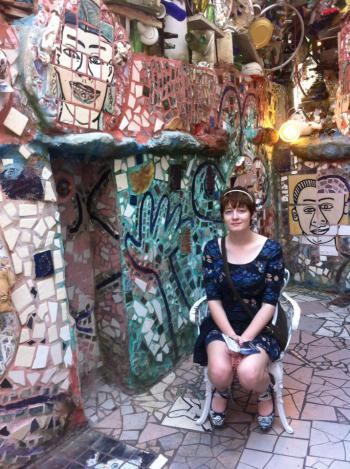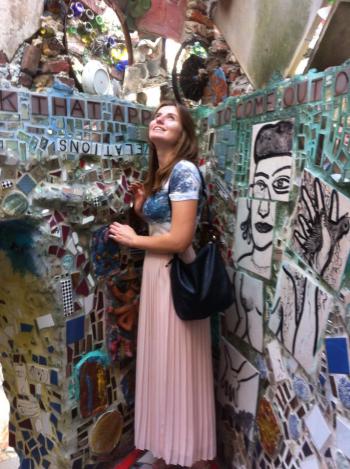Serendip is an independent site partnering with faculty at multiple colleges and universities around the world. Happy exploring!
To Play, or not to Play (Critically)

 In Mary Flanagan’s Critical Play, she does an impressive job of painting critical play in a light that implies that it is superior to plain old play. She defines it as “a means to create...play environments and activities that represent one or more questions about aspects of human life.” She states that play is “fun, voluntary, and intrinsically motivated.” I think she implies that plain play does not render useful results. Yet she does grudgingly quote Johan Huizinga where he says “All art derives from play.” When Hanna and I visited the Mosaic Gardens last weekend, this quote could be used to describe Zagar’s whole masterpiece. I understand that critical play is an effective means of creating art, but it is not the best means to enjoy art.
In Mary Flanagan’s Critical Play, she does an impressive job of painting critical play in a light that implies that it is superior to plain old play. She defines it as “a means to create...play environments and activities that represent one or more questions about aspects of human life.” She states that play is “fun, voluntary, and intrinsically motivated.” I think she implies that plain play does not render useful results. Yet she does grudgingly quote Johan Huizinga where he says “All art derives from play.” When Hanna and I visited the Mosaic Gardens last weekend, this quote could be used to describe Zagar’s whole masterpiece. I understand that critical play is an effective means of creating art, but it is not the best means to enjoy art.

I did some reflecting over the weekend on how I play critically. I found that I don’t like to question society when I’m daydreaming or watching the Newsroom or writing a letter to my best friend in California. As Flanagan defines it, critical play is critical when you have a goal in mind to question something bigger than you. Otherwise it’s just play. I like to write microfiction, create things in my dorm room that remind me of easier times, and take photographs of breathtaking things. I create with a motive in mind. I create to illustrate a point I feel needs pointing out. While I enjoy doing this, it is not “true” play to me because I’m actively using my brain and sweating over the piece. I feel that if I put as much brainpower into the short story I’ve been writing as into this particular essay, I can’t enjoy the process as much.
The same goes for when I look at someone else’s work. When my good friend Emily and I when to Tate Modern in London this summer, our experience was dampened somewhat by us by trying to determine if this piece was in fact, art. We asked ourselves “Is it art because it’s in a museum?” and “Is it not art anymore if a toddler could recreate it?” I was perturbed by all the deep questions I couldn’t answer. Methinks I would’ve enjoyed myself much more if we had just let our eyes and legs wander through the rooms, and not assessing a piece past our gut instinct (meaning whether or not we’d have it in our living rooms). I do understand that we might not have exercised the art to its full potential. However, I feel that I do this in school ten months out of the year. I need a break from the underlying uncertainty of meaning.
I remembered this uneasy feeling at the Mosaic Gardens. Hanna and I had a blast frolicking amongst the beer bottles and old plates and quotes like “Can a city feel?” We had no structure, no need to assess. We just enjoyed the atmosphere and pretended to be models and took many model-y type pictures. We did not look past face value. Judging by the atmosphere that seemed to invite us to just wander around and marvel, Zagar might not have wanted us to analyze his life’s work to death. I think he would have just been content with us having a good time looking at it. Because of this, Hanna and I managed to relax, enjoy, and plain play.
In Critical Play, Flanagan talks of movies and performance art and their influence upon art and culture. Here, I reluctantly admit that it is harder to plain play whilst watching an artsy movie like Requiem for a Dream or The Artist. For some reason, moving art like movies and dance performances force the viewer to look past face value. Perhaps it is because of the unforeseen twists and turns, or the visual feast that change in a frame (or in a matter of moments). Seeing “real” people in conflicts such as “man versus society” or “man versus himself” make us relate in ways that paintings and sculptures cannot because they are not abstract wisps. Yet, I still feel that if I try to analyze the movie when I don’t strictly have to, I don’t enjoy it as much. Isn’t one of the central goals of art is to provide an escape from brutish reality?
I think that escape provision is the fundamental goal of games. According to Flanagan, Monopoly was created by a social activist “to protest landlords and tax policies.” But Anne’s family turn into greedy capitalists whenever they play the game. Which (I assume) is not reality, or their “real” behavior. I also tentatively assume that if people knew that the game is a critique of our tax policy, people would play the game differently. Depending on the players’ personality, he might not enjoy the “get out of jail free” card because he’s too busy trying to figure out what it’s trying to point out about society.
But to each their own. I hate Monopoly.



Comments
"To each their own"?
Tessa--
You're missing your second reader--I wonder where she is?
And you seem MIA re: reading your classmates' work? What's up?
Your argument seems to be that critical play may be an effective means of creating, but not the best for enjoying, art. For you, you show--but can you (how can you?) generalize from your own experience for us all?
Is enjoyment (not education/expansion/questioning) the goal here?
Who gets to define the purpose of art (or whether or not it has one)?
Do Zagar's wishes matter here? (Why?)
I'd like to ask you to revisit your claim that escape is the fundamental goal of games, with assistance from the TED talk by Jane McGonigle, "Gaming Can Make a Better World," which Tomahawk called to our attention. Let me know what you think of McGonigle's refusal of the binary you've constructed....
I'd like to revisit the matter of intentionality, too, which we worked so hard in class last week.
Finally: how to build on what you've done here, and expand on it for next week?
What if you re-start the paper with escapism, and see where you can go from t/here?
Tessa's structure
Tessa's essay seems to pulsate between the little experiences and the larger ideas.
She appears to have a thesis in the last line of the first paragraph, synthesizing the ideas she read from Flanagan's work and stating that critical play is not the best way to enjoy art. She cites several separate examples of how this idea intersects with her experience in the city and regular life, and how the ideas of "critical play" have, at times, ruined the act of play for her.
She draws upon the example of monopoly to justify that even something created with the idea of Critical Play in mind still is best enjoyed when not playing critically; raising for me a question of intent. If something is intended to promote Critical Play, but is not approached by the viewer as such, does it still have the same effect?